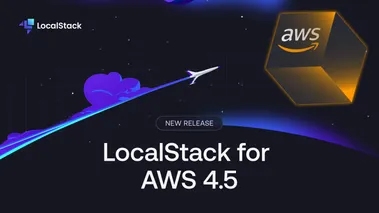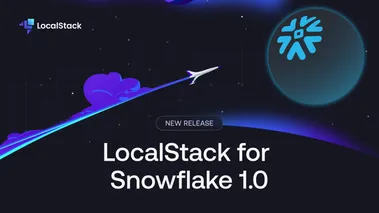Announcing LocalStack 3.0 General Availability!
We are excited to announce the release of LocalStack 3.0, which features enhanced AWS services, Chaos Engineering tools, IAM Policy Stream, Desktop Application, improved performance, and more!
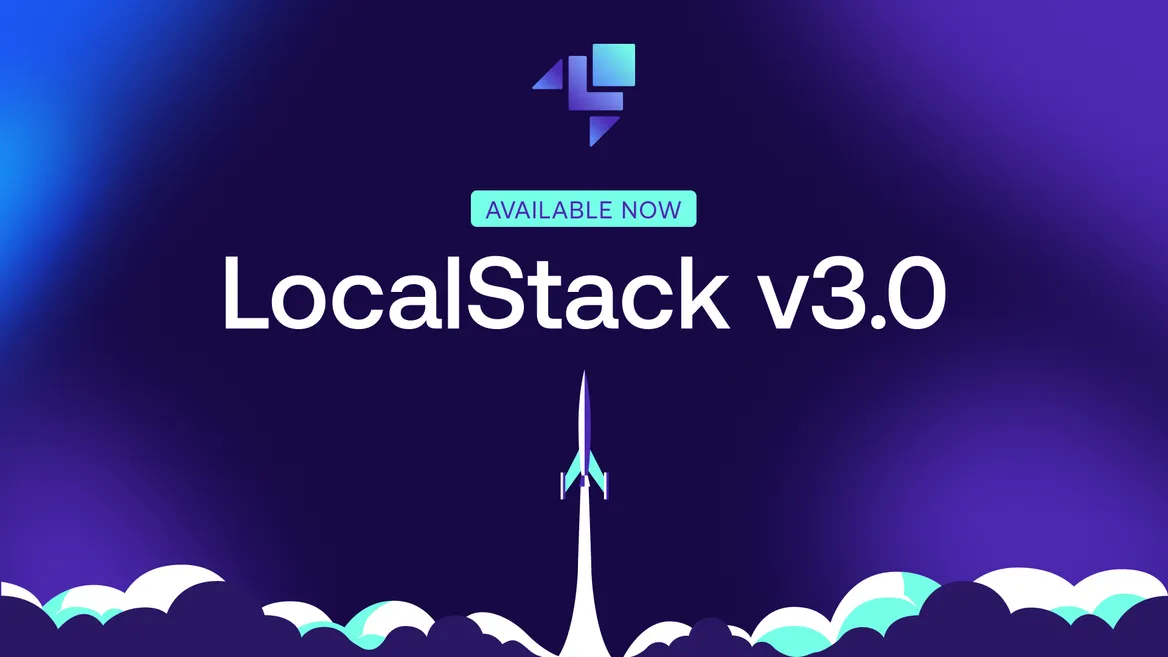
Today, we are excited to announce LocalStack 3.0, our latest major release aiming to empower developers with a high-fidelity local cloud development & testing experience. Earlier this year, we unveiled LocalStack 2.0, which brought forth many new features and improvements, along with better integration with the AWS tooling ecosystem. With the 3.0 release, we’re doubling down on our promise to boost developer productivity and tackle the issues that often slow down cloud software development and delivery workflows — specifically, simplifying onboarding and eliminating the inefficiencies that lead to prolonged development and test cycles. Additionally, this release represents a significant milestone in our journey as we move beyond traditional cloud emulation and introduce innovative features that promise to reshape the way developers construct resilient cloud applications.
Whether you’re a LocalStack user or just getting started on your cloud development journey, we have a lot of exciting features to share with you! With LocalStack, you can now:
- Test disaster recovery simulations such as region failover, DNS failover, and service failures.
- Explore and progressively tighten security around IAM policies as your application takes shape.
- Create ephemeral cloud sandboxes for testing your infrastructure locally or on CI pipelines.
- Activate analytics for LocalStack in CI runs to get insights into your infrastructure test runs.
- Utilize enhanced, faster AWS services such as S3, Step Functions, DynamoDB and ElastiCache.
- Start with a fully local developer environment with the new LocalStack Desktop Application.
And much more! LocalStack makes it easy to build & test local-first cloud applications, all while improving the inner dev loop. We are excited to share our recent developments in this release and discuss how you can get started with them!
What’s new in LocalStack 3.0?
In previous releases, we supplemented our cloud emulation capabilities with parity, performance, and interoperability. In LocalStack 3.0, our core areas of focus have been — resilience, efficiency, and flexibility. With LocalStack, we aim to power your local development productivity and cover the most sophisticated enterprise use cases. Collectively, the new features in the release won’t just cut away your slow code → deploy → test → redeploy → … loops, but also help your team to confidently ship faster and more secure cloud applications. You can explore all the new features by upgrading your LocalStack setup or downloading LocalStack 3.0 today! Get your free LocalStack account.
Let’s take a look at our latest release’s new features and enhancements to see how you can get the most out of them!
- What’s new in LocalStack 3.0?
- New S3 provider
- New Step Functions provider
- New ElastiCache provider
- New features for Chaos Engineering
- IAM Policy Stream on Web Application
- Ephemeral Environments for LocalStack (Preview)
- CI Analytics for LocalStack (Preview)
- All-new LocalStack Desktop Application
- Multi-region and Multi-account support
- LocalStack Networking initiative
- Miscellaneous
- Get started with LocalStack 3.0
- What’s next?
New S3 provider
The new native S3 implementation, introduced in version 2.3.0, is now the default S3 provider in LocalStack 3.0. The new S3 provider offers improved parity with AWS features, significantly enhanced performance and persistence support, and reduced memory usage for large object uploads/downloads and multipart uploads. The provider brings advanced support for AWS-specific features such as bucket versioning, pagination in List operations, precondition headers, S3 Object Lock and Legal Hold, and default Bucket Encryption settings.
S3 is a core AWS service, and undertaking our own implementation was crucial to further improve the parity of our services with AWS. We have also improved performance, with some massive upgrades for some operations including:
- An approximate 10% increase in throughput for operations like
PutObject,DeleteObject,GetObject, andHeadObjectwith small files (1 KB to 100 KB), and a 30% increase for 10 MB files. - A 2.5 times throughput boost for
ListObjectsV2and a 16 times increase forListObjectVersions. - A 33% throughput improvement in multipart uploads.
Check out our S3 documentation for more information.
New Step Functions provider
We’re excited to announce a new native implementation of Step Functions, featuring several enhancements and additional capabilities compared to the previous provider. This update significantly expands support, including extended handling of timeouts and heartbeats, state machine versioning, Map states, and integration with EventBridge. It also includes support for the latest set of Intrinsic Functions. A major focus of this update is the improved API parity with AWS Step Functions, aligning more closely with its functionalities.
Our commitment to enhancing the Step Functions implementation continues. In the upcoming months, users can expect further exciting additions such as express workflows, expanded service integrations, and activity support, among others. The adoption of this new native implementation streamlines our ability to introduce new features and address issues in Step Functions more efficiently than ever before.
Check out our Step Functions documentation and Discuss post for more information.
New ElastiCache provider
We have introduced a new ElastiCache provider with significantly improved AWS parity and resolving issues around the Redis cluster management in the previous provider. The new provider implements a dedicated Redis control plane to manage Redis instances in non-cluster mode and cluster mode. The new provider will be extended in the future to test automatic failover, snapshotting, scaling replication groups, and more features.
These latest enhancements mark a significant step forward in our commitment to delivering a more robust and fine-tuned ElastiCache provider. The old ElastiCache provider is temporarily available in LocalStack v3 using PROVIDER_OVERRIDE_ELASTICACHE=legacy but we highly recommend migrating as soon as possible since we will drop support for this in LocalStack v4.
New features for Chaos Engineering
Chaos engineering is a practice focused on improving system resilience by intentionally introducing disruptions. To support this, we’re introducing a new Chaos Engineering dashboard in the LocalStack Web Application. This feature allows users to conduct fault injection experiments within their application stack. The dashboard offers various Fault Injection Simulator (FIS) experiment options, such as:
- Disrupt a percentage of all incoming requests and return 500 errors instead.
- Disrupt a percentage of requests made against a specific region.
- Simulate the complete outage of a specific region.
- Introduce latency to all API calls to simulate network service degradations.

Additionally, we have introduced user guides for various scenarios, including simulating unexpected outages using the LocalStack Outage Extension, implementing Route53 Failover with FIS, and configuring error probabilities in Kinesis & DynamoDB.
These resources are designed to help users effectively respond to such scenarios, facilitating the development of thorough disaster recovery plans. By using these tools, teams can prepare to sustain stability and efficiency even in challenging situations. Check out our documentation for more information.
IAM Policy Stream on Web Application
In application development, accessing AWS resources like S3 buckets and RDS databases is common. To grant access, we create IAM roles and attach policies that specify permissions. However, determining the correct permissions can be challenging, often leading developers to assign excessive permissions to IAM roles. To address this, LocalStack introduced the IAM Policy Stream. This tool simplifies identifying the necessary permissions for cloud applications and helps detect logical errors.
We have expanded the IAM Policy Stream feature to be accessible directly through the Web Application, in addition to the existing CLI feature. This enhancement will display the specific policy generated for each API call in the new interface, simplifying permission management and eliminating concerns about assigning correct permissions.
The features include:
- A real-time list of calls and the corresponding policies they generate.
- A real-time summary policy that combines all individual policies into a single comprehensive policy.
- The option to enable or disable this feature during runtime, allowing for performance optimization as needed.
- The ability to reset the stream, enabling a fresh start with a new set of policies.
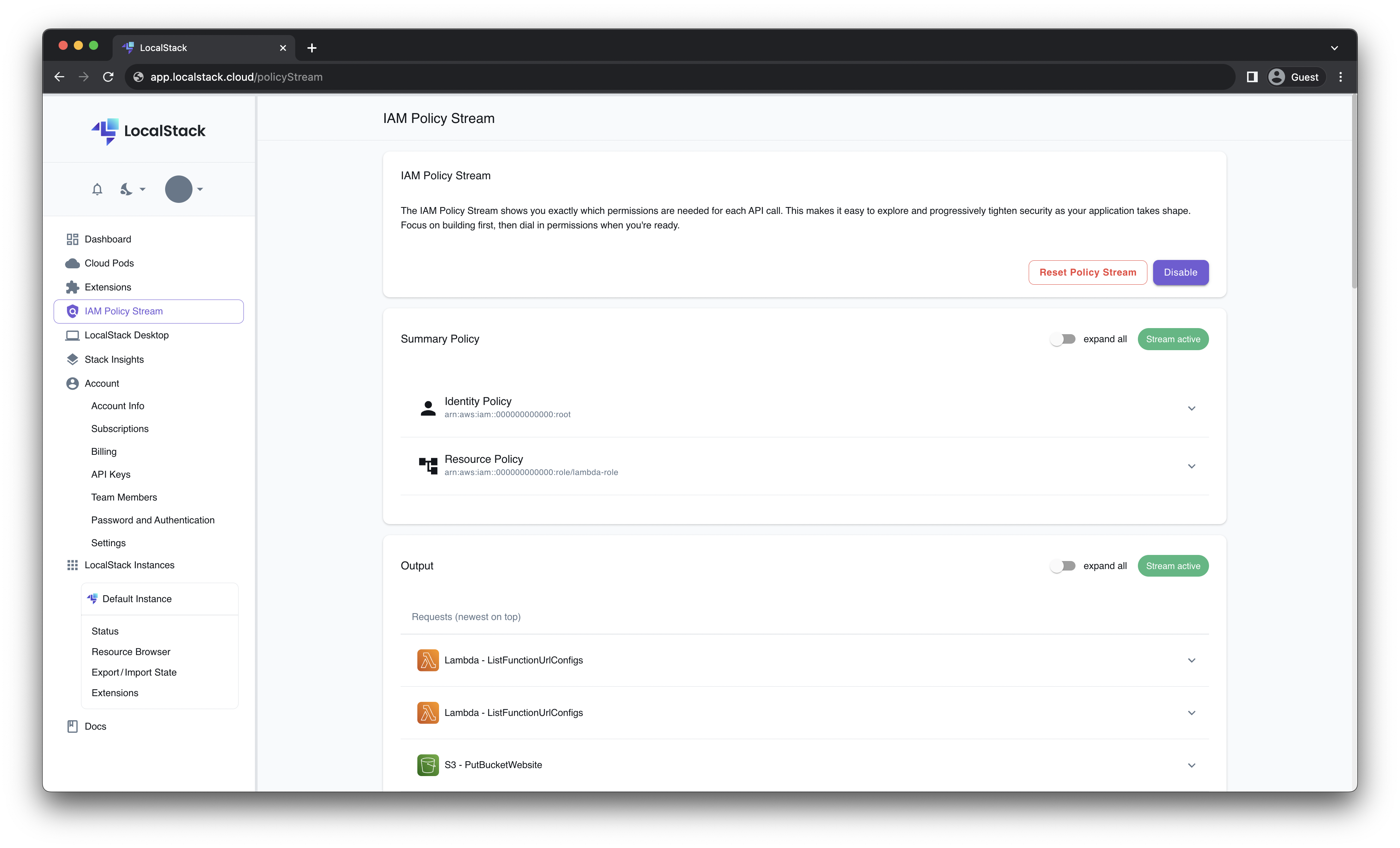
Check out our documentation on getting started with the IAM Policy Stream.
Ephemeral Environments for LocalStack (Preview)
We have launched Ephemeral Instances, which allows you to run a LocalStack sandbox in the cloud, instead of your local machine. This ephemeral environment is a short-lived, encapsulated deployment of LocalStack which will be terminated after 90 minutes. With these sandboxes, you can run your tests, preview features in your AWS-powered applications, and collaborate asynchronously within and across your team!
With Ephemeral Instances, you can use the same set of features that you use while running LocalStack locally, including the Resource Browser, State Management (Cloud Pods), and Extensions! While on your local machine, you can switch the AWS Service Endpoint URL to point to the deployed sandbox URL to get started! Ephemeral Instances also allows you to generate an preview environment from GitHub Pull Request (PR) builds.
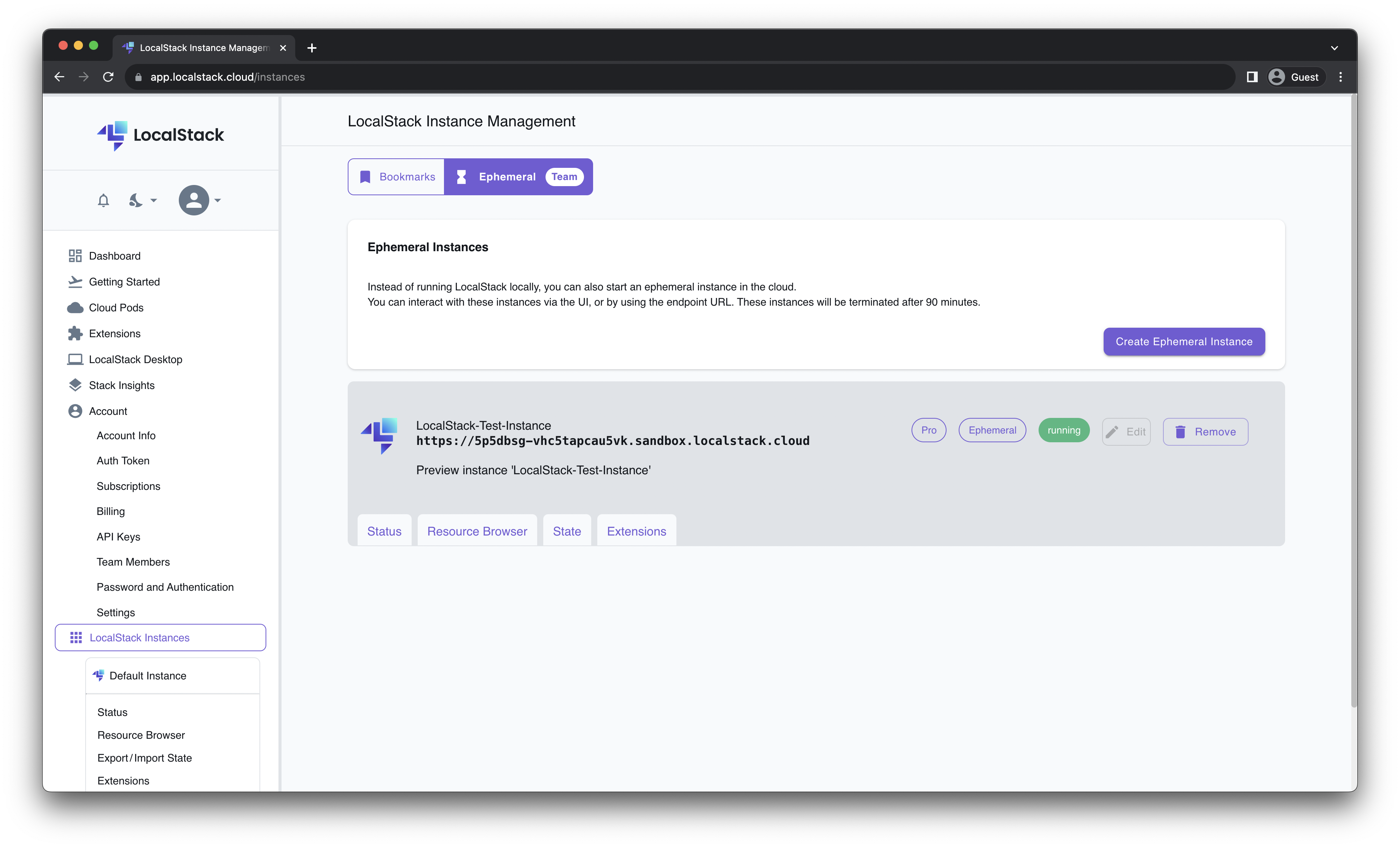
Check out our documentation on getting started with Ephemeral Instances. The feature is in private preview, and you can reach out to us to get early access!
CI Analytics for LocalStack (Preview)
We’re excited to introduce CI Analytics, a new feature for comprehensive state browsing and analysis of historical continuous integration (CI) builds. This feature integrates into your LocalStack CI workflow, offering insights and supporting our goal to enhance the cloud developer experience throughout the software development lifecycle (SDLC). With CI Analytics, you can collect, analyze, and visualize critical metrics from your software CI pipelines, helping you understand the impact of cloud infrastructure changes on CI builds. It facilitates root cause analysis for build failures, supports data-driven decisions for continuous improvement, and more.
CI Analytics combines a number of existing features in the LocalStack platform, such as Cloud Pods & Stack Insights, and provides a unified view of the state of your LocalStack resources across CI builds. The features include:
- CI Project Runs: This gives you a consolidated view of all CI builds for a specific project.
- Log Output: You can view detailed log output for individual CI builds.
- Request/Response Traces: This feature provides traces of requests and responses, including details of the AWS service and operation, along with expandable request and response payloads.
- Cloud Pod State: It allows you to view the state of LocalStack resources for a particular CI build through a Cloud Pod, which can be injected locally or loaded in an Ephemeral Instance.
- Stack Insights: This offers a view and audit log of interactions, API error codes in your application stack over time, and enables you to drill down into the most commonly used services and API calls.
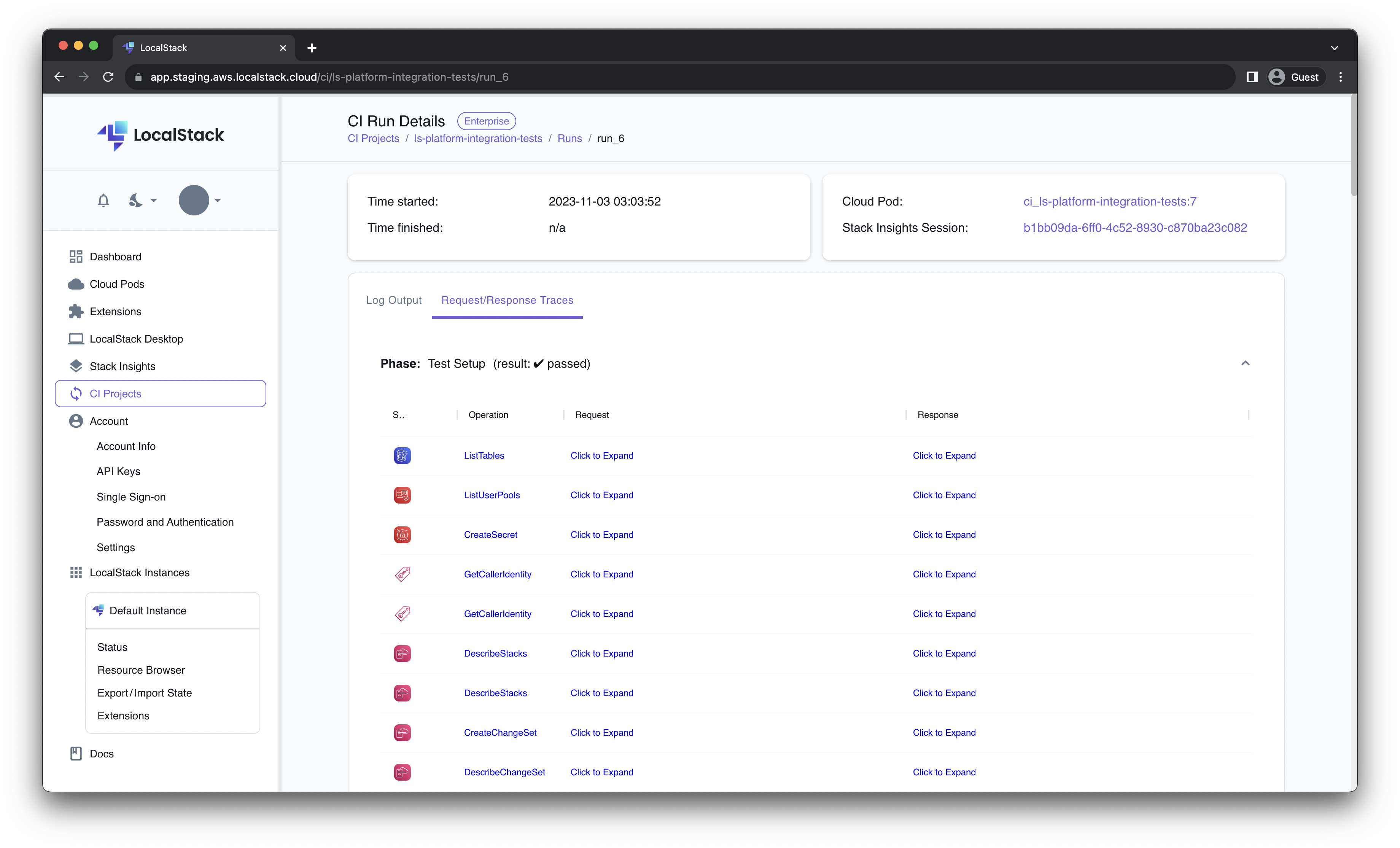
Check out our documentation on getting started with CI Analytics. The feature is in private preview, and you can reach out to us to get early access!
All-new LocalStack Desktop Application
We’re excited to announce the release of the LocalStack Desktop Application, our cross-platform Desktop client. The Desktop Application features an intuitive user interface, with local Resource Browser for 30+ AWS services and a simplified way to manage LocalStack containers and logs. The new Desktop Application replaces the LocalStack Cockpit, streamlining the developer experience and making our cloud emulator tooling more accessible. Download it for free and get started!.

Check out our announcement blog for more information.
Multi-region and Multi-account support
Multi-account and multi-region support within LocalStack has been continuously enhanced through incremental updates. We’ve completely reworked the way services interact with each other internally, significantly broadening our support for IAM enforcement in inter-service integrations. This structural change is pivotal in advancing our multi-account and multi-region capabilities.
Several providers, including the new Step Functions provider, CloudWatch, EventBridge, Glue, and more, have seen improvements in their multi-account and multi-region awareness. Notably, SQS is now inherently compatible with multi-accounts, thanks to the introduction of a new default URL endpoint strategy.
In addition, there has been a significant revamp in the way ARNs are constructed internally. This change is particularly beneficial for users working with LocalStack in scenarios involving non-default account IDs or regions. It ensures the generation of more accurate ARNs, aligning closely with real-world AWS environments and enhancing the overall user experience with LocalStack.
LocalStack Networking initiative
Over the past few years, LocalStack’s configuration options have expanded to accommodate a wide range of use cases, particularly in networking configuration. This includes setting up the listen address for the LocalStack container and configuring domain names for services like SQS or OpenSearch.
However, this expansion resulted in an excess of configuration variables, some of which were redundant or overlapping in functionality. Additionally, there was inconsistency in how these variables were used across different services — some services relied on one set of variables, while others used different ones, and some didn’t support configuration adjustments at all.
To simplify and standardize this process, LocalStack 2.0 introduced two new configuration variables: GATEWAY_LISTEN and LOCALSTACK_HOST. Building on this, LocalStack 3.0 further standardizes configuration across all LocalStack services. As part of this update, we have eliminated several older configuration variables, including EDGE_PORT, EDGE_PORT_HTTP, EDGE_BIND_HOST, LOCALSTACK_HOSTNAME, and HOSTNAME_EXTERNAL, streamlining the configuration experience and enhancing overall usability.
View our Networking migration guide for more details!
Miscellaneous
- We’re introducing a simplified method for managing team licenses. Instead of activating LocalStack with API keys, we’re shifting to the use of Auth Tokens. This approach facilitates the assignment of licenses to users without necessitating changes to their environment setup. Read our documentation for more information.
- We’ve massively improved write performance for DynamoDB in LocalStack, with our benchmarks showing a 60% faster
PutItemoperation. Using higher batch sizes will profit even more from this change, withBatchWriteItemnow being 6.2x faster for 10 items and 9.9x faster for 25 items. That means if you’re populating a large DynamoDB table, you can now take advantage of much faster insertion times! For the best performance please setDYNAMODB_IN_MEMORY=1, but even without this, you should still notice a significant performance improvement. - To limit which services can be started by LocalStack, we have (re-)introduced the concept of Strict Service Loading, where only the services defined in the
SERVICESvariable, are going to be started. This also lays the foundation for us to provide standalone images for single services or combinations thereof. - We’re also currently in the progress of internally refactoring our CloudFormation resource implementations to be more in parity with AWS and also structurally easier for us and contributors to work with. If you’re interested in contributing, please reach out to us!
Get started with LocalStack 3.0
We have many LocalStack 3.0 resources for new and existing users. To learn more about the new functionalities and features of LocalStack 3.0, you can:
- View our release notes on GitHub.
- Navigate to our Developer Hub and try out sample applications to get started.
- Attend our LocalStack Community Event to know more about the 3.0 release.
To get started with using LocalStack 3.0 features:
- Migrate to LocalStack 3.0 by following our migration documentation.
- Migrate your LocalStack networking configuration by following our networking migration guide.
- Connect with us on LocalStack Discuss for feedback, bug reports, or suggestions.
LocalStack 3.0 would not have been possible without the invaluable support, community discussions, and bug reports we’ve received via our GitHub Issues and Discuss posts. We’d like to thank all our dedicated users who are driving forward our vision for a new era where building & testing cloud applications locally is the norm.
What’s next?
As we continue to push out new features in our platform & core emulator, the fundamental goal remains the same: Providing the best tooling and empowering cloud developers to enable a seamless dev experience across the entire development lifecycle. A cornerstone in our approach is to keep the developer experience, product quality, and user feedback at the forefront of our efforts. Your active participation has been the bedrock of our progress!
Stay tuned for more news and awesome features in the upcoming months - we couldn’t be more excited and pumped to work with our huge user base across the globe - and we’re just getting started. 🚀 If you happen to be attending AWS re:Invent this year, come meet us there at Booth #1074 in the main Expo hall!
Thank you for your support and welcome to LocalStack 3.0!


